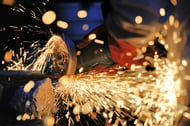If pressure transducers are exposed to a manufacturing environment that exceeds the suppliers specified limits, sensor issues will occur. during storage or assembly. An original equipment manufacturer (OEM) design engineer should take note of the following six conditions while designing a system to be manufactured and shipped to an end-user.
1. Temperature
Excessively high temperatures are a common source of pressure transducer issues, they consist of numerous components that only function within specified temperature ranges. Transducers that are exposed to temperatures exceeding those ranges during the assembly process can be negatively affected.
For instance, a pressure transducer installed on a steam line very close to where the steam is being  generated will cause a negative change in the dynamics of the sensor. In this case, a simple solution can be to move the transducer further away from the steam line.
generated will cause a negative change in the dynamics of the sensor. In this case, a simple solution can be to move the transducer further away from the steam line.
2. Voltage Spikes
Voltage spikes are short duration s of electrical transients in voltage. These high-energy surges only last a few milliseconds, but still can cause damage. They are often extremely difficult to trace unless the source is obvious, such as lightning. OEM engineers must be aware of their entire manufacturing environment and beyond for potential risks for failure. A conversation with the pressure transducer supplier can be helpful in identifying and eliminating this type of problem.
3. Fluorescent Lighting
Fluorescent lamps require an initial high voltage to start the electrical arc through the argon and mercury, which heats the mercury until it becomes a gas. This initial voltage spike presents a potential problem for pressure transducers. Additionally, the magnetic field that fluorescent lighting creates can induce voltages into transducer wires, which the control system may misinterpret as an actual output signal. As a result of these issues, transducers should not be located underneath or within close proximity to fluorescent lighting.
4. EMI/RFI
A pressure transducer converts pressure into an electrical signal and is, by nature, susceptible to the negative effects of electromagnetic emissions or electrical disturbances. Transducer manufacturers do their best to protect the transducer from outside disturbances, but certain design considerations could reduce or prevent EMI/RFI (electromagnetic interference/radio frequency interference) effects. Other EMI/RFI sources to avoid include contractors, power lines, computers, walkie talkies, cell phones and large machinery that produce varying magnetic fields. The most common ways of reducing EMI/RFI noise are shielding, filtering and suppression. Contact the pressure transducer manufacturer for help on how these preventative measures can be implemented.
5. Shock and Vibration
Shock and vibration can cause a wide range of problems, including dented enclosures, disconnected wires, broken circuit boards, faulty signals, intermittent problems and shortened life. To prevent shock and vibration during the assembly procedure, OEMs should first realize this potential problem and take appropriate measures to prevent it. A simple solution is to install transducers as remotely as possible from obvious sources of shock and vibration. Depending on the installation, another possible solution can be the use of shock and vibration isolators.
6. Overpressure
Once an OEM has assembled the machine, either on their manufacturing floor or at the end-user’s location, be aware of overpressure. Causes of overpressure include fluid hammer, unintentional heat applied to the system and a faulty pressure regulator. Pressure transducers can withstand occasional pressures up to their proof pressure rating, eventually returning to their natural state. Pressures that reach burst pressure can rupture the diaphragm or case and cause leakage. Pressures above proof but below burst pressure can result in permanent diaphragm deformation, causing an output shift.
To prevent overpressure, OEM engineers must understand the dynamics of their system and the limits of the transducer. As they design it, they need to be aware of the interaction of pumps, control valves, balancing valves, check valves, pressure switches, motors, compressors, tanks and other system components.
CLICK HERE to learn how to properly design a sensor into a pressure decay leak detection system.


